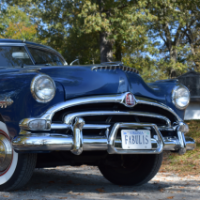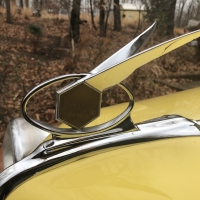308 Aluminum Head w/ 0.5" Head Bolts -- Gasket and Torque Setting?
Comments
-
advice I was given and follow-
I saw the Forum about the Best Gaskets.,and my take is as follows. I have had Blown Fire Rings on a number of the Gaskets Iron and Aluminum Heads. But not on the old style Metal Sand witch Type. If you look very close to the Fire Ring and the very Small and NARROW Fold they have clamping force on the Composition and the Fact that if you hold the new gasket in hands you can Move some of the so called Fire Ring from side to side a small amount. The Ring is not wide enough, then look at one of the old style Metal type ( fel-Pro) or Victor and you will see that the Fire-Ring is Part of One Side of the metal gasket and it is folded over by machine and becomes the Ring itself. This makes the Ring very strong as it is part of the make up. The head and Gasket will move a very small amount under power, That is why Manufacturers of Engines do not install dowells to block to Cyl heads. Chuck had a Best Gasket with 1/2 holes and Aluminum head 7/16 to Distort and actually elongate The Fire Rings on each cyl. with not to many miles. ( the 1/2 inch holes let the gasket move over till the 7/16 studs touched the holes in the gasket. It was torqued to 65-70 ft lbs ) He now uses the metal gasket on his Hudson Aluminum heads with No Gasket failures.
0 -
More from Ivan--
PROPER INSTALLATION OF HUDSON ALUMINUM HEADS Ivan Zaremba - Aluminum Heads
Some notes by Ivan Zaremba on the subject- (Ivan is a professional classic race car mechanic-
restorer) “I have worked with aluminum cylinder heads for fifty years without “wearing out the spark plug threads”.
Anti-seize—sure! Torque them in another iron head—Bah Humbug! Just torque them to the recommended figure. The need for re-torque of the head bolts multiple times at intervals until it does “come down” any further is also key. I don’t think I consider it done until after 500 miles of running and 3,4, or 5 torque sessions.
The corrosion and erosion issues with aluminum heads are real. They can be dealt with by using distilled water with coolant and, additionally, not letting the engines sit dormant. The curious chemistry of the corrosion inhibitors in coolants/antifreeze is such that at the location where electrolytic corrosion occurs between dissimilar metals, those inhibitors are consumed locally. The coolant must be circulated by running the engine to leave coolant with inhibitors in the problem areas. That is why vehicles that are driven daily or regularly do not have this problem and “hobby” cars that are run occasionally do. You may have noticed where a radiator hose is clamped over an aluminum part (and there is therefore no circulation) you always find the white aluminum corrosion evident. So change the coolant annually and run the engine to open the thermostat weekly. Some restorers actually paint these areas under the hose with an epoxy that shields the aluminum. Such is my work world—that where $50K engine overhauls
are common. Check out my company website: www.philreillycompany.com/index.htm ”
More From: Ivan Zaremba
Use Copper Coat (or aluminum paint) on both sides of the gasket lightly, sealer like
Permatex on the bolt threads and motor oil under the head of the bolt. Initially, use the standard
shop manual sequence and a lower torque figure like 40 ft/lbs, but after the first 9 fasteners are
done, go back to the beginning and go over them in sequence again and then go on to do the
next 6. Then go back to the first one again and do the 15 again and continue through the last 6.
Then repeat the whole 21 starting at the beginning. Now you are ready to move the torque value up to 50 ft/lbs and go through that “wave” technique to insure that the head pulls down evenly.
Increase the torque and repeat until you reach the final value. Walt Mordenti would tell you that letting the torqued head sit overnight and repeating the final pull in the morning is the thing to do!
After starting the engine and bringing it up to normal temp with the thermostat opening and water circulating fully, shut it off and wait at least four hours for it to cool off and do the first re-torque. The re-torque does not involve the “Clifford Waves”. Just back the fasteners off 1/8 to 1/4 turn pull them to torque. I mark a line crossways on the heads of the fasteners with a felt pen after the first heat cycle and re-torque. This gives a visual indication of the change as the head gasket “comes down”. Basically, when you re-torque and all the fasteners stay with the marks in the same position, you are finished. The Best gaskets do not require as many re-torque sequences as the NOS Felpro and the original type gaskets. I do it after the first heat cycle, after 25 miles, after 100 miles, and again after 500.
Sounds complicated, but results are worth it!
0 -
Kdancy, What part number and supplier for the metal head gasket? Thanks, Fred0
-
I have an aluminum head on all my Hornet's and cant add anything to the advice above other than mention I use real large diameter grade 8 flat washers.
0 -
@Kdancy I think I've seen portions of this text elsewhere on this forum. Thank you for including it here, it's very helpful! Like @TwinSupercharged I'm interested in a part number for one of the gaskets you described and a starting torque spec for the half-inch bolts.I see you mentioning torquing to the "recommended figure" as part of the procedure, but I would like to know what that figure is
 I would not expect the same as stock studs with iron heads (60-65 ft-lbs), whereas iron heads with half-inch bolt mods get torqued up to 80 ft-lbs. In increments of course.Additionally I appreciate the anti-corrosion advice. This car is driven more than once per week and I will continue to change the coolant frequently, before it becomes acidic.@Ol racer, thanks. I will continue to use the grade 8 flat washers and copper spray that have worked well for me thus far.0
I would not expect the same as stock studs with iron heads (60-65 ft-lbs), whereas iron heads with half-inch bolt mods get torqued up to 80 ft-lbs. In increments of course.Additionally I appreciate the anti-corrosion advice. This car is driven more than once per week and I will continue to change the coolant frequently, before it becomes acidic.@Ol racer, thanks. I will continue to use the grade 8 flat washers and copper spray that have worked well for me thus far.0 -
If I remember right, Rudy started finding cracks radiating out from the head bolt holes when he started torquing at 80lbs. I believe he had two blocks that did it and he went back to 70lb torque. I believe Walt recomended the higher torque value, and that is when Rudy tried it.
0 -
Remember: torque aluminum heads cold.0
-
FYI
I agree, need Not tighten 1/2" stud 'Nuts' to 80# to seal gasket if follow above process since its actually possible to pull up (crack) the cylinder block Deck....0 -
@Kdancy wow, that's some impressive damage from a Walt tip. I'm pretty sure he's the one that convinced me to start doing it that way as well. It's been a good ten years without any cracks in the block or leaks in the BestGasket, but I guess it's never too late to mess something up.@Ol racer maybe I should clarify: I'm using block inserts with grade 8 bolts for greater strength, not original-style studs and nuts. That may or may not have an impact on what you're describing.0
Categories
- 36.9K All Categories
- 113 Hudson 1916 - 1929
- 20 Upcoming Events
- 92 Essex Super 6
- 28.6K HUDSON
- 573 "How To" - Skills, mechanical and other wise
- 995 Street Rods
- 151 American Motors
- 178 The Flathead Forum
- 49 Manuals, etc,.
- 78 Hudson 8
- 44 FORUM - Instructions and Tips on using the forum
- 2.8K CLASSIFIEDS
- 608 Vehicles
- 2.2K Parts & Pieces
- 77 Literature & Memorabilia
- Hudson 1916 - 1929 Yahoo Groups Archived Photos


